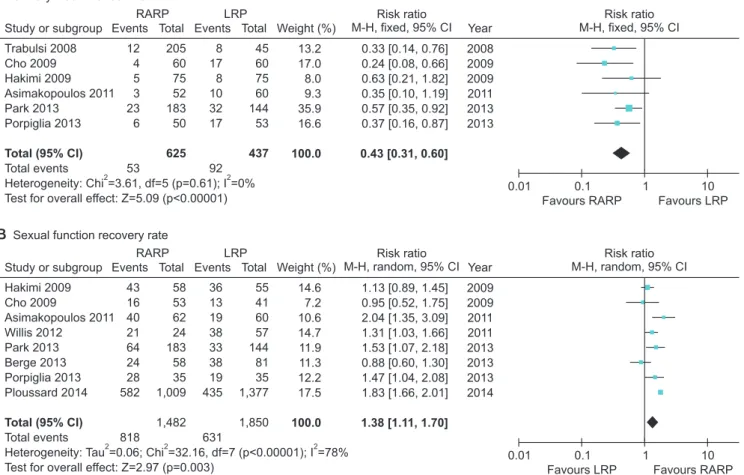383
Robot-assisted radical prostatectomy has lower biochemical recurrence than laparoscopic radical prostatectomy: Systematic review and meta-analysis
Seon Heui Lee, Hyun Ju Seo, Na Rae Lee, Soo Kyung Son, Dae Keun Kim, Koon Ho Rha
Investig Clin Urol 2017;58:152-163. https://doi.org/10.4111/icu.2017.58.3.152
In this paper, Fig. 3B (forest plot of sexual function recovery rate) was incorrectly misprinted. The authors sincerely regret this error. The Fig. 3B should be corrected as follows: Labelling of favours RARP and favours LRP should be swapped.
Corrected Figure
CORRIGENDUM: Correction of the Figure
ⓒ The Korean Urological Association, 2017
www.icurology.org
Investig Clin Urol 2017;58:383.
https://doi.org/10.4111/icu.2017.58.5.383 pISSN 2466-0493 • eISSN 2466-054X
Fig. 3. Cumulative analyses of robot-assisted radical prostatectomy comparing laparoscopic radical prostatectomy in functional outcome (A: Urinary
incontinence rate, B: Sexual function recovery rate). RARP, robot-assisted radical prostatectomy; LRP, laparoscopic radical prostatectomy; M-H, Mantel- Haenszel; CI, confidence interval; df, degrees of freedom.
Study or subgroup
RARP LRP
Events 12
4 5 3 23 6
53 Total
205 60 75 52 183 50
625
Weight (%)
100.0 13.2 17.0 8.0 9.3 35.9 16.6
Risk ratio M-H, fixed, 95% CI
0.33 [0.14, 0.76]
0.24 0.63 0.35 0.57 0.37
[0.08, 0.66]
[0.21, 1.82]
[0.10, 1.19]
[0.35, 0.92]
[0.16, 0.87]
0.43 [0.31, 0.60]
Events 8 17 8 10 32 17
92 Total
45 60 75 60 144 53
437
A
10 Favours LRP Favours RARP
1 0.1
0.01 Urinary incontinence rate
Risk ratio M-H, fixed, 95% CI Trabulsi 2008
Cho 2009 Hakimi 2009 Asimakopoulos 2011 Park 2013
Porpiglia 2013
Total events
Heterogeneity: Chi =3.61, df=5 (p=0.61); I =0%
Test for overall effect: Z=5.09 (p<0.00001) Total (95% CI)
2 2
Year 2008 2009 2009 2011 2013 2013
Study or subgroup
RARP LRP
Events 43 16 40 21 64 24 28 582
818 Total
58 53 62 24 183 58 35 1,009
1,482
Weight (%)
100.0 14.6 7.2 10.6 14.7 11.9 11.3 12.2 17.5
Risk ratio M-H, random, 95% CI
1.13 [0.89, 1.45]
0.95 [0.52, 1.75]
2.04 [1.35, 3.09]
1.31 [1.03, 1.66]
1.53 [1.07, 2.18]
0.88 [0.60, 1.30]
1.47 [1.04, 2.08]
1.83 [1.66, 2.01]
1.38 [1.11, 1.70]
Events 36 13 19 38 33 38 19 435
631 Total
55 41 60 57 144 81 35 1,377
1,850
B
10 Favours LRP Favours RARP
1 0.1
0.01 Sexual function recovery rate
Risk ratio M-H, random, 95% CI Hakimi 2009
Total events
Heterogeneity: Tau =0.06; Chi =32.16, df=7 (p<0.00001); I =78%
Test for overall effect: Z=2.97 (p=0.003) Cho 2009
Asimakopoulos 2011 Willis 2012
Park 2013 Berge 2013 Porpiglia 2013 Ploussard 2014
Total (95% CI)
2 2 2
Year 2009 2009 2011 2011 2013 2013 2013 2014
